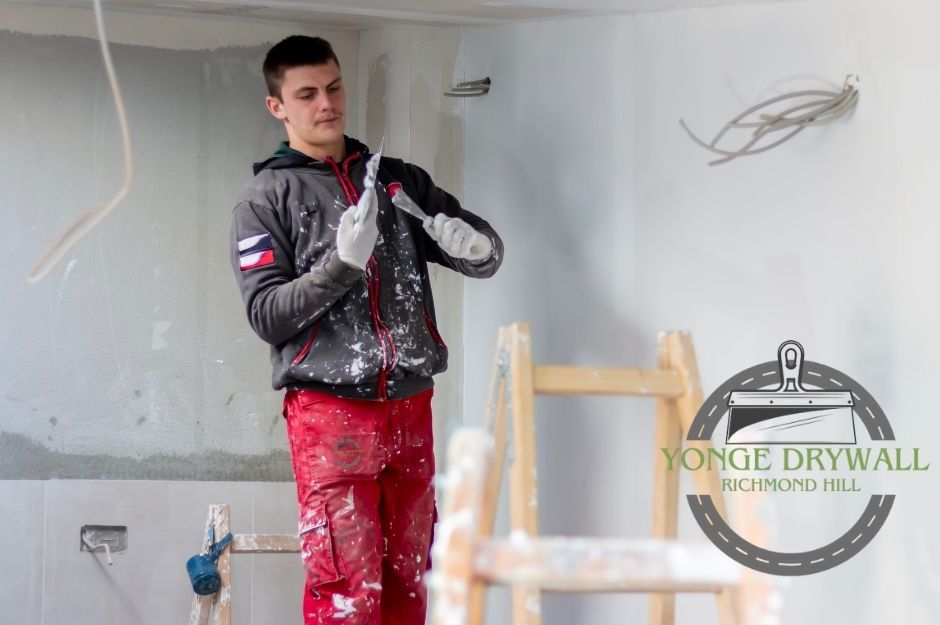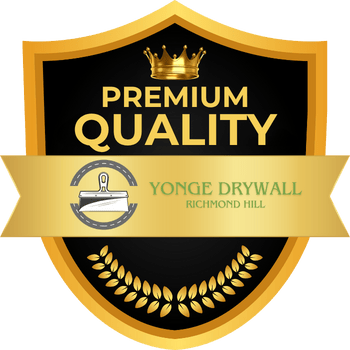Drywall Repair Oshawa
Top-Quality Drywall Repair Service Company in Oshawa, Ontario

Drywall damage in your Oshawa home can range from minor dings to major water damage, but finding the right repair company makes all the difference. Whether you're dealing with ceiling cracks, unsightly popcorn textures, or holes that need patching, professional drywall services at Yonge Drywall Richmond Hill restore your walls and ceilings to their original condition.
Professional drywall companies in Oshawa offer comprehensive solutions that include repair work for cracks and water damage, specialized installation services like soundproof drywall, and expert finishing techniques such as texturing and mudding. These services address both cosmetic issues and structural concerns that can affect your home's value and safety.
Understanding your options for drywall repair, installation, and finishing helps you make informed decisions about your home improvement projects. The right contractor will assess your specific needs and recommend solutions that fit your budget while delivering lasting results.

Yonge Drywall Richmond Hill (HP)

Comprehensive Drywall Repair Services in Oshawa
Professional drywall repair services in Oshawa address common issues like ceiling cracks, popcorn texture removal, hole patching, and water damage restoration. These specialized techniques require proper tools and expertise to achieve seamless results.
Ceiling Crack Solutions
Ceiling cracks develop from structural settling, temperature changes, or moisture fluctuations. Small hairline cracks can be repaired with mesh tape and joint compound.
Larger cracks require more extensive preparation. The damaged area needs cleaning and widening to remove loose material. Professional contractors apply fiberglass mesh tape for reinforcement.
Multiple coats of joint compound create a smooth finish. Each layer must dry completely before sanding and applying the next coat.
Common crack types include:
- Hairline stress cracks
- Corner cracks at joints
- Settling cracks from foundation movement
Proper primer and paint matching ensure invisible repairs. Quality drywall repair eliminates recurring crack problems when done correctly.
Popcorn Ceiling Removal Techniques
Popcorn ceiling removal requires careful preparation and safety measures. The textured surface often contains asbestos in homes built before 1980.
Professional removal starts with plastic sheeting to protect furniture and floors. The popcorn texture gets sprayed with water to soften the material.
Scraping tools remove the dampened texture without damaging the underlying drywall. Some areas may need multiple water applications for complete removal.
Removal process steps:
- Asbestos testing if applicable
- Room preparation and protection
- Texture moistening with spray bottles
- Systematic scraping with putty knives
- Surface smoothing and primer application
Smooth ceiling finishes require joint compound application to fill imperfections. Sanding creates the final smooth surface ready for painting.
Effective Hole Patching
Hole patching methods depend on the damage size and location. Small nail holes need only lightweight spackle and light sanding.
Medium holes up to 4 inches require mesh patches or self-adhesive repair kits. The patch covers the hole while joint compound fills the surrounding area.
Large holes need drywall backing for proper support. Cut a piece of drywall slightly larger than the hole for backing material.
Patching supplies needed:
- Joint compound
- Mesh or paper tape
- Putty knives in various sizes
- Sandpaper (120 and 220 grit)
- Primer and matching paint
Professional drywall repair ensures patches blend seamlessly with existing walls. Multiple thin coats work better than single thick applications.
Water Damage Restoration
Water damage requires immediate attention to prevent mold growth. Damaged drywall must be completely dried within 24-48 hours.
Severely water-damaged sections need complete replacement rather than repair. Cut out affected areas at least 12 inches beyond visible damage.
Moisture meters help identify hidden water penetration in wall cavities. Proper ventilation and dehumidification speed the drying process.
Water damage assessment includes:
- Moisture level testing
- Mold inspection
- Structural integrity checks
- Insulation condition evaluation
New drywall installation follows standard procedures with proper joint taping and finishing. Antimicrobial primers prevent future mold issues in previously damaged areas.
Specialized Drywall Installation Options
Professional drywall companies in Oshawa handle complex installation projects that go beyond basic wall construction. These specialized services address structural issues, acoustic requirements, and ceiling panel replacements with precision and expertise.
Replacing Damaged Ceiling Panels
Water damage, structural settling, and age can compromise ceiling drywall panels beyond simple repair. Professional contractors assess the extent of damage to determine whether patching or full panel replacement provides the better solution.
Removal Process:
- Cut around damaged sections carefully
- Remove fasteners and old panels
- Inspect underlying structure for damage
- Clean debris and prepare mounting surfaces
New panels must match existing thickness and type. Standard ceiling drywall ranges from 1/2 inch to 5/8 inch thickness. Fire-rated panels may be required in certain areas of your home.
Installation involves securing panels to ceiling joists with appropriate fasteners. Screws placed every 8-12 inches ensure proper support. Contractors blend seams with surrounding drywall through careful taping and mudding techniques.
Soundproof Drywall Installation
Soundproof drywall installation creates quieter living spaces through specialized materials and techniques. These systems reduce noise transmission between rooms, floors, and from external sources.
Material Options:
- QuietRock panels: Pre-manufactured sound-dampening drywall
- Mass-loaded vinyl: Added between standard drywall layers
- Resilient channels: Metal strips that decouple drywall from framing
- Acoustic insulation: Sound-absorbing materials within wall cavities
Double-layer installation provides superior sound control. The first layer attaches to framing, followed by acoustic treatment, then the final drywall layer. Green glue or similar damping compounds between layers enhance performance.
Proper sealing around electrical outlets, switches, and fixtures prevents sound leaks. Contractors use acoustic caulk and gaskets to maintain sound barriers.
Addressing Sagging Ceilings
Sagging ceilings require immediate attention to prevent collapse and property damage. Multiple factors cause this problem, from inadequate fastening to moisture damage and structural movement.
Assessment Steps:
- Identify sagging extent and location
- Check fastener condition and spacing
- Examine joists for damage or movement
- Test for moisture issues
Minor sagging may only require additional fasteners and drywall repair to damaged areas. Severe cases need complete panel removal and reinstallation with proper support.
Contractors install blocking between joists when needed. This provides additional attachment points and prevents future sagging. New fasteners must penetrate structural members by at least one inch for adequate holding power.
Expert Drywall Finishing Techniques
Quality drywall finishing requires precise mudding applications, systematic taping methods, and proper texturing techniques. These fundamental processes ensure seamless repairs and professional-grade wall surfaces.
Professional Mudding Practices
Mudding forms the foundation of quality drywall work. Proper mud consistency determines the final surface quality and repair durability.
Use a 6-inch knife for initial coats and progress to 10-12 inch knives for finishing passes. Apply thin, even layers rather than thick applications that create ridges or bubbles.
Three-coat system requirements:
- First coat: Fill joints and cover tape
- Second coat: Feather edges 2-3 inches beyond first coat
- Final coat: Extend 2-3 inches beyond second coat for smooth blending
Allow each coat to dry completely before sanding. Light sanding between coats removes imperfections without damaging the underlying work.
Temperature and humidity affect drying times significantly. Maintain room temperature between 65-75°F with moderate humidity levels for optimal results.
Precise Taping Applications
Paper tape provides superior strength for most applications, while mesh tape works well for small repairs. Proper tape embedding prevents future cracking and ensures long-term durability.
Apply a thin mud layer along the joint before positioning tape. Press firmly with your knife to remove air bubbles and excess compound underneath.
Critical taping steps:
- Center tape over joints precisely
- Apply consistent pressure during embedding
- Remove excess mud immediately
- Check for proper adhesion along entire length
Corner applications require folding paper tape along the crease. Inside corners need careful attention to maintain sharp, straight lines without excess buildup.
Outside corners benefit from metal or plastic corner beads for added protection and crisp edges.
Texturing for Visual Appeal
Texture application conceals minor imperfections while adding visual interest to repaired surfaces. Matching existing textures requires specific tools and techniques.
Common texture types and methods:
| Texture Style | Application Tool | Technique |
|---|---|---|
| Orange Peel | Spray gun | Light, random pattern |
| Knockdown | Trowel/knife | Apply then flatten peaks |
| Stipple | Brush/roller | Dabbing motion |
| Skip Trowel | Trowel | Irregular sweeping strokes |
Practice texture techniques on scrap material before applying to finished surfaces. Consistent hand pressure and overlapping patterns create uniform appearances.
Allow textures to dry partially before final shaping. Timing varies by humidity and material thickness, typically 10-30 minutes for most applications.
